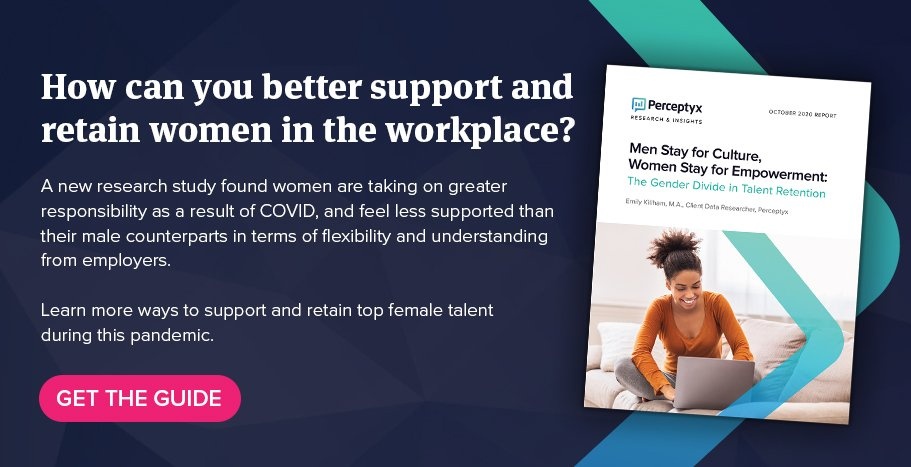The novel coronavirus has created a lot of novelty in our world: new ways to work, new ways for students to learn, and new opportunities for organizations to get creative when it comes to retaining top talent. Unfortunately, it has also revealed and re-established traditional expectations for female caregivers, with potentially long term consequences and far reaching effects.
Organizations know this and are asking: “How can we improve the experience for female caregivers? How can we retain our top female talent, when they are being pulled in multiple directions?”
To better answer those questions, we conducted a nationwide survey of over 1,500 working adults.
Keeping with Tradition
For families with young children, women are facing a heavier load than men when it comes to childcare responsibilities, both during and outside of their workday. Nearly 55% of women carry 75% or more of the responsibility for the children during the workday, compared with only about 41% of men. However, as women take higher-level positions in an organization, that gap between genders in senior positions narrows. And when asked about the portion of labor associated with scheduling and making arrangements for the children, even more of the responsibility fell to women. This gap, while also narrowing in senior roles, further illustrates that, regardless of job position, some traditional gender roles are holding firm.
Supporting Productivity
This additional caregiving responsibility has proved to be a challenge for organizations and employees alike as they try to accomplish their work with myriad distractions during the workday. Not surprisingly, most caregivers are experiencing difficulty while having children at home, with 60% of parents reporting at least a moderate level of distraction, and 54% saying their productivity will be affected to at least a moderate degree.
However, women are doing a better job with the juggling of family responsibilities and work. Those female caregivers providing at least 75% of the care during the workday report less distraction and productivity loss than do their male counterparts, even when compared to those who provide less than 25% of the childcare per day. Despite their apparent success in balancing the load, across the caregiving responsibility spectrum, at each level women are reporting less organizational and managerial support and flexibility.
Retaining Women
The immediate concern of this imbalance of responsibility and support is the loss of these women, who are maintaining productivity despite everything going on. And the risk is real: A full third of female respondents said they would need to make a change to their current working arrangement in the next six months, and 23% have already looked for a new job with different or fewer hours.
Understandably, organizations are looking for new and unique ways to support their employees who are attempting to work while also managing caregiving responsibilities, such as overseeing distance learning for their children. But it turns out, these solutions may not be effective in solving the challenges of balancing the demands of work and caregiving through this pandemic, especially for women. Our research revealed that none of the “perks” employers are offering—things like assistance finding childcare, setting alternative schedules, or providing extra time off—actually increased women’s connections with the organization or their likelihood to stay.
So what is working for women? Understanding, flexibility, power over their work schedules, and getting out of their way. While offering extra time off did help bind men to the organization, female caregivers didn’t see any bump in engagement with that benefit. Instead, the women we studied were 2.5 times more likely to strongly agree that they would stay with the organization for the next year if their manager was understanding about their unique needs during this time. When managers were understanding, female caregivers were 17% less likely to say they needed to make a change in the next six months, indicating increased connection to the organization.
The most frequent change women have made for themselves is working a different, self-managed schedule, maintaining the same number of hours. Women who have made this change on their own are significantly more likely to be with their organization one year from now than those who have not. Interestingly, when women said their organizations imposed flexible schedules, there was no significant difference with regard to the likelihood of continuing employment.
Best Bets For Organizations
As organizations look for ways to support and retain female caregivers during this ongoing pandemic, the key won’t be programs dictated by leadership. Instead, senior leaders need to be flexible, and managers need to individualize. Women know best how to maintain productivity and avoid distractions within their environments—if they are given the freedom to do it.
For organizations, this approach doesn’t cost a thing. Nor does it require a fancy program or some shiny object. What’s required is listening, and taking action to enable employees. Employees are more than willing to tell you what they need; it’s imperative that you act on what you hear.
And it doesn’t have to stop when COVID-19 fades into our rearview mirror. Empowering and trusting women to tell you how they will best handle their work and family responsibilities will help to retain them not only in the months ahead, but well into the future.

